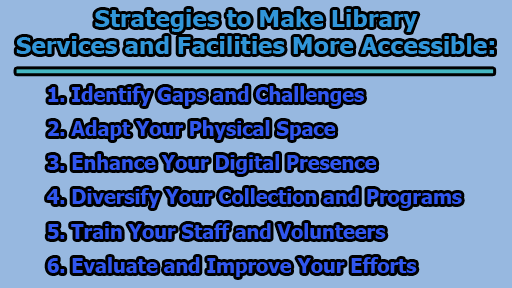Strategies to Make Library Services and Facilities More Accessible:
Libraries play a pivotal role in our communities, serving as hubs of knowledge, culture, and community engagement. To fulfill their mission effectively, it is crucial for libraries to be accessible to all, regardless of physical abilities, backgrounds, or identities. In this article, we will explore various strategies to make library services and facilities more accessible and assess the current situation to bridge existing gaps.
1. Identify Gaps and Challenges: The first step towards improving accessibility is identifying the gaps and challenges within your library. Gathering feedback from users, staff, and stakeholders through surveys, focus groups, audits, and accessibility checklists is crucial. Consulting with experts, organizations, or networks specializing in accessibility and inclusion can offer valuable insights into meeting the needs and expectations of diverse patrons. Understanding the challenges is the foundation for creating an inclusive library environment.
2. Adapt Your Physical Space: The design and layout of a library can significantly impact accessibility. To create a welcoming and comfortable space, libraries should ensure it is well-lit, ventilated, free of clutter and hazards. Adding ramps, elevators, automatic doors, adjustable furniture, and clear signage can facilitate mobility and navigation. Moreover, designated areas for quiet study, sensory stimulation, and assistive technology should be available. These physical adaptations enhance the library’s appeal to patrons with various needs.
3. Enhance Your Digital Presence: In our digital age, libraries must not only focus on physical accessibility but also improve their digital presence. Many users access library services and resources online. To ensure an accessible and user-friendly online experience, libraries should adhere to web accessibility standards and guidelines like WCAG 2.1. This ensures that digital content is readable, understandable, and operable for people with different abilities and devices. Providing alternative formats, such as audio, video, or text transcripts, further enhances digital accessibility. Libraries can also use social media, newsletters, or blogs to communicate with their online audience and promote accessibility initiatives.
4. Diversify Your Collection and Programs: One of the key ways to make libraries more accessible is by offering a diverse and inclusive collection and a variety of programs. Libraries should adopt collection development policies and practices that support diversity and representation. This means selecting materials from diverse authors, publishers, and perspectives. Providing materials in different languages, formats, and difficulty levels can accommodate diverse literacy and learning needs. Libraries should also design and deliver programs and events that celebrate diversity and inclusion, such as book clubs, workshops, or festivals.
5. Train Your Staff and Volunteers: The success of accessibility initiatives heavily depends on library staff and volunteers. Investing in their professional development by offering training on topics like disability awareness, cultural competence, and universal design is essential. Encouraging staff to adopt positive attitudes and behaviors, such as empathy, respect, and flexibility when interacting with diverse patrons, fosters an inclusive environment. Recruiting and retaining staff and volunteers from diverse backgrounds and experiences also contributes to enhancing library diversity and inclusion.
6. Evaluate and Improve Your Efforts: The final step in making a library more accessible is monitoring and evaluating your efforts and outcomes. Libraries can use statistics, feedback, and testimonials as measures and indicators to assess the impact and effectiveness of their accessibility initiatives. These results should be used to identify the strengths and weaknesses of the library and to plan for future improvements and innovations. The ultimate goal is to ensure that libraries continuously strive for accessibility and excellence.
In conclusion, creating an inclusive and accessible library environment is not just a noble goal but a necessary one. By identifying gaps and challenges, adapting physical spaces, enhancing digital presence, diversifying collections and programs, training staff and volunteers, and regularly evaluating their efforts, libraries can make significant strides toward improving accessibility. Libraries are not just buildings filled with books; they are places where communities come together, learn, and grow. Ensuring accessibility means ensuring that everyone has the opportunity to participate in this vibrant communal experience.

Library Lecturer at Nurul Amin Degree College










